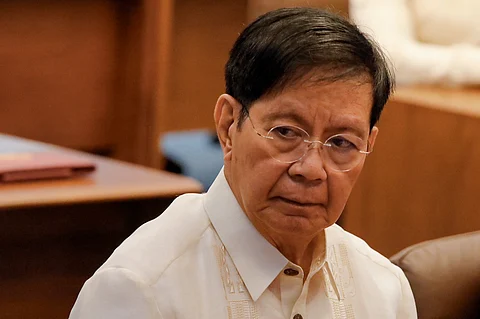
- NEWS
- the EDIT
- COMMENTARY
- BUSINESS
- LIFE
- SHOW
- ACTION
- GLOBAL GOALS
- SNAPS
- DYARYO TIRADA
- MORE

Senator Panfilo “Ping” Lacson on Thursday launched a scathing exposé of systemic corruption in the country’s flood control projects, unveiling what he dubbed a “CORRUPTIONary” — a dictionary of terms used in underground government transactions — which he mentioned in his privilege speech in a recent plenary session.
Lacson unveiled a set of coded terms reportedly used by public officials and contractors to disguise illicit financial schemes that have siphoned off an estimated P1.9 trillion in taxpayers’ money over the past 15 years.
"In the course of our research and investigation, we encountered several words – their meanings, we could not find in the dictionary. So we looked somewhere else. Alas! We found them – in the ‘corruptionary,’” Lacson declared.
Among the initial entries in Senator Lacson’s so-called “corruptionary” are “Distinct,” which refers to multiple budget items in the General Appropriations Act bearing the same contract cost—an apparent code indicating project “ownership” by specific individuals, as seen in Bulacan’s 1st engineering district where several riverbank protection projects, each priced at P77.199 million, turned out to be ghost projects; “Reseta,” a 2–3% kickback demanded by the District Engineering Office, likened to a prescription that contractors are forced to “swallow”; “Passing Through” or “Parking Fee,” a 5–6% cut given as a form of “royalty” to politicians who control the districts where projects are implemented; and “Funders,” referring to politicians who insert projects into the national budget and typically receive 20–25% of the total project cost in return.
Lacson highlighted a glaring example of this manipulation in Barangay Mulawin, Naujan, Oriental Mindoro, where P1.1 billion in flood control project funding was inserted into the House version of the budget.
The barangay, originally slated for three projects worth P810 million, saw that number grow to eight projects with a total allocation of P1.9 billion.
“The remaining P1.1 billion was inserted – I repeat – inserted in the House version,” he emphasized.
The senator broke down the budgetary leakages, noting that even before corruption takes its toll, the cost of flood control projects is already reduced by 5% for Value-Added Tax (VAT), 2% for withholding tax, 1% for bonds and insurances, 1% for materials testing, and an allowable contractor’s profit of 8 to 10%.
That leaves only about 82% of the budget for the actual project — and according to Lacson, even this remaining portion is further divided among various players: 8–10% goes to DPWH officials (with at least 6% allotted to district engineers), 2–3% to the District Engineering Office, 5–6% to members of the Bids and Awards Committee, 0.5–1% to the Commission on Audit, 5–6% as local political “toll fees,” and a substantial 20–25% to the project’s “funder.”
“This is well-orchestrated by an organized network of people who abuse their power,” Lacson warned, pointing to what he called a “syndicate” operating within Bulacan’s DPWH office.
He described how this group allegedly borrows contractors’ licenses to process and complete paperwork for projects that are never actually implemented — essentially turning in falsified documents to justify payment for non-existent infrastructure.
“A group in the 1st District Engineering Office is a known syndicate of substandard and ghost projects. It uses contractors' licenses to implement projects or process documents to show the ghost projects were 'completed'," Lacson said.
In response to the revelations, Lacson renewed his call for “greed control,” urging Congress to implement mechanisms that hold legislator-proponents accountable for their budget insertions.
Lacson lamented that legislator-insertions should be attributed to their proponents “so they can also be made answerable for substandard and ghost projects they had proposed or sponsored.”
